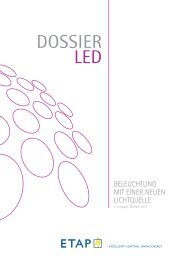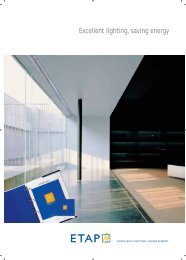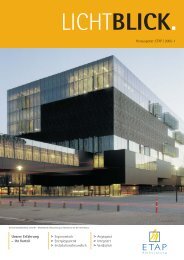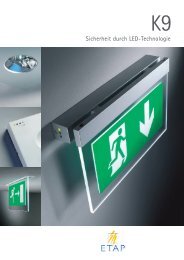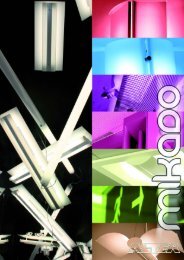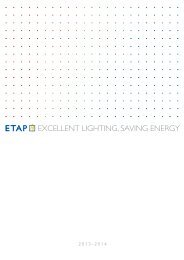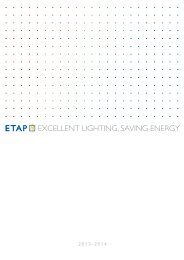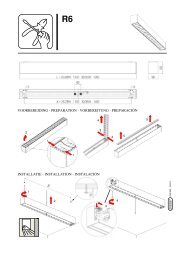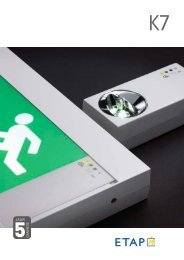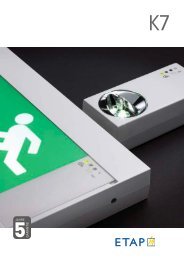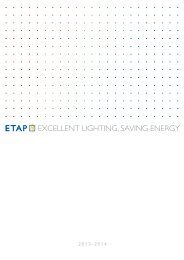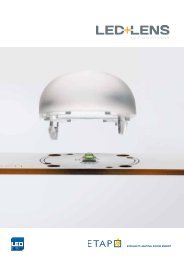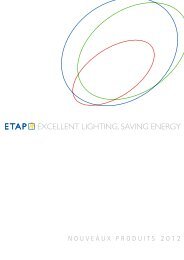Lightpoint 2012-2 - ETAP Lighting
Lightpoint 2012-2 - ETAP Lighting
Lightpoint 2012-2 - ETAP Lighting
Create successful ePaper yourself
Turn your PDF publications into a flip-book with our unique Google optimized e-Paper software.
D2 downlights with LED<br />
K9 emergency lighting:<br />
more unobtrusive than ever<br />
LIGHTPOINT.<br />
LEDs and light control,<br />
a perfect combination<br />
Downlight with LEDs:<br />
the smart choice<br />
An <strong>ETAP</strong> publication | <strong>2012</strong>-2
x CONTENTS<br />
New products<br />
K9 emergency lighting:<br />
more discreet than ever<br />
K2 emergency lighting:<br />
6<br />
Full and water-resistant range with LEDs 8<br />
R8: even more attractive with LEDs 9<br />
Downlight with LEDs: the smart choice<br />
E5: efficient and comfortable lighting<br />
10<br />
for large spaces 12<br />
E8: high-level lighting 14<br />
LED report<br />
Cost recovery period for LEDs 2<br />
LEDs and light control, further savings 4<br />
In the spotlight<br />
VINCI Park:<br />
full renovation of car park lighting 16<br />
News<br />
Eco-lamps – the new standard 15<br />
GreenLight Awards <strong>2012</strong> 18<br />
<strong>ETAP</strong> informs 19<br />
This document has been compiled by <strong>ETAP</strong> with the greatest<br />
possible care. However, the information contained in this<br />
publication is not binding and may change due to technical<br />
development. <strong>ETAP</strong> is not liable for any damage whatsoever<br />
resulting from the use of this document.<br />
2 | LIGHTPOINT.<br />
k LED REPORT COST RECOVERY PERIOD FOR LEDS<br />
LEDs – how long will it take you<br />
to recover the extra cost?<br />
LEDs are the light source of the future, there is no doubt about it. But is it worth replacing<br />
your existing installation today? <strong>ETAP</strong> helps you on your way to correctly assess the cost<br />
recovery period.<br />
Calculating the cost recovery period for an LED<br />
lighting installation seems simple at first sight.<br />
On the one hand, there is the higher upfront<br />
cost of LEDs, on the other hand the potential<br />
savings thanks to their low power consumption<br />
and long service life.<br />
Yet there still are quite a few misconceptions<br />
in this regard, since anticipated cost recovery<br />
periods are highly variable, depending on<br />
the source. Some manufacturers guarantee<br />
cost recovery periods ranging from one to<br />
three years, whilst sceptics refer to financially<br />
unachievable cost recovery periods of ten years<br />
or more. In order to ensure a correct calculation,<br />
first and foremost, the application and various<br />
other factors have to be taken into account.<br />
Number of LEDs determines extra cost<br />
The extra cost of an LED installation, first and<br />
foremost, lies in the LED itself. The more LEDs<br />
are required in an installation, the higher the<br />
extra cost will be compared to traditional<br />
solutions. LEDs become rapidly cost effective<br />
in applications requiring relatively low light<br />
levels, as in emergency lighting. Replacement<br />
with LEDs is also quickly worth the cost in<br />
spots (e.g., 2.5 years). This is due, among other<br />
things, to the high consumption and short service<br />
life of halogen lamps, which are traditionally<br />
used in these applications. For downlights<br />
the cost recovery periods for LED luminaires<br />
are also relatively short (3 to 7 years): compact<br />
fluorescent lamps are not the most efficient<br />
light source, the lumen packets are relatively<br />
low and service life is average.<br />
Take the burning hours into account<br />
A second factor to consider is the number of<br />
burning hours. The more burning hours, the<br />
higher the energy savings and the faster the<br />
extra cost of the LEDs will be recovered. This is
costs<br />
1 2 3 4 5 6 7 8 9 10 11 12 1 2 3 4 5 6 7 8 9 10 11 12<br />
1 2 3 4 5 6 7 8 9 10 11 12<br />
years<br />
years years<br />
Cost recovery period for the renovation of old installations<br />
with halogen spots vs. installation with LED spots, for 3,000<br />
burning hours/year and an energy price of € 0.15/kWh.<br />
often overlooked in simulations. The difference between 8 and 24 hours of<br />
lighting a day adds up to several thousands of burning hours per annum,<br />
which in this case comes down to a three times shorter cost recovery<br />
period.<br />
Their long service life leans strongly in favour of LEDs in applications with<br />
a high number of burning hours, since the replacement cost for an installation<br />
with fluorescent lighting can quickly add up, in particular in lighting<br />
installations at heights or in hard-to-reach places.<br />
Renovation – cost recovered faster than you would think<br />
In calculating cost recovery periods, the existing situation, the so-called<br />
baseline, must be taken into account. Whoever owns a recent lighting<br />
installation today with efficient luminaires with fluorescent lamps, is<br />
looking at a very long cost recovery period when switching to LEDs. But<br />
in practice, there are quite a few buildings with lighting installations<br />
20 years and older. The replacement of said installations with an LED<br />
solution is in fact cost-effective. In <strong>ETAP</strong>'s experience, we anticipate the<br />
cost recovery period to be 5 to 10 years.<br />
costs<br />
Cost recovery period for the renovation of an old installation<br />
with downlights (1*26W TC-T) vs. installation with LED<br />
downlights, for 3,000 burning hours/year and an energy price<br />
of € 0.15/kWh.<br />
costs<br />
LED installation Old scenario<br />
Cost recovery period for the renovation of an older office<br />
lighting installation with fluorescent lamps (2*36W) and a<br />
traditional ballast vs. LED installation with U7/R7, for 3,000<br />
burning hours/year and an energy price of € 0.15/kWh.<br />
In addition, the cost recovery period for LED installations will further<br />
decrease in the future, as LEDs increase in efficiency, their cost price<br />
drops and energy prices rise. Specialists assume that the efficiency of<br />
LEDs still increases by 10 % every year. Yet this should not be a reason to<br />
further delay replacement, since a new lighting installation comes with<br />
quite a few further advantages such as combined use with light control<br />
systems (see page 4-5), improved comfort, etc.<br />
Take all aspects into account<br />
Calculating cost recovery periods and comparing solutions is no easy task.<br />
Any choice you make will impact the eventual result. For example, the<br />
colour temperature of the LEDs will play an important role in the installation's<br />
power consumption. Also keep an eye on the quality of the solutions<br />
provided by your supplier. Always ask for the quality record and check, for<br />
example, what the extrapolated life expectancy is at actual temperatures in<br />
the luminaires. Also check the light studies, as it makes no sense to compare<br />
solutions, which are not guaranteed to achieve the required light levels.<br />
Would you like to know what the cost recovery period is for your specific application?<br />
Contact your <strong>ETAP</strong> advisor, who will be more than happy to assist you.<br />
3 | LIGHTPOINT.
k LED REPORT LEDS AND LIGHT CONTROL<br />
4 | LIGHTPOINT.<br />
LEDs and light control, further savings<br />
U7 with light control system (ELS)<br />
LEDs are not only an energy-efficient light source; they also<br />
work in perfect harmony with light control systems. This<br />
combination results in a high savings potential, but also leads<br />
to further advantages: LEDs can be dimmed more efficiently<br />
than fluorescent lamps and their service life is not shortened<br />
by frequent switching.<br />
The most commonly used light control systems are movement<br />
dependent controls, which dim or switch the lights when users enter<br />
or leave the space, and daylight dependent control, whereby the light<br />
is dimmed depending on the amount of daylight the room receives.<br />
A combination of both systems can save 55 % energy or more in specific<br />
scenarios. Currently one out of six luminaires marketed by <strong>ETAP</strong>,<br />
is equipped with individual daylight dependent control.<br />
Individual, local or central<br />
Light control systems can be applied in several ways. Daylight<br />
dependent control and movement detection are often applied to a<br />
luminaire, with an integrated sensor that controls the light in one<br />
luminaire. But it is also possible for an entire room, whereby all<br />
luminaires in a single space are controlled by a central sensor or a<br />
compact light control system, such as EasyDim. And it is possible<br />
throughout a building, whereby the lighting in the building is controlled<br />
by a central system, such as Excellum.<br />
< The new light control system (ELS) saves approximately 30% more energy.<br />
R7 with movement dependent light control (on request)
LEDs are less sensitive to switching<br />
LEDs have a number of specific properties that make them particularly<br />
suitable for use with light control systems. For example,<br />
frequent switching has no impact on the service life of LEDs, in<br />
contrast with fluorescent lamps, where a small portion of the emitter<br />
material in the lamp is lost each time it is switched on. A symptom<br />
of emitter loss can be visual as it causes end-blackening. In spaces<br />
with a relatively short presence –just think of lavatories, for example<br />
or corridors –we see that the replacement frequency for fluorescent<br />
lamps quickly adds up.<br />
LEDs do not have that problem, since an LED is an electronic component,<br />
which is not sensitive to frequent switching. Furthermore<br />
LEDs immediately respond with full luminous flux when switched on,<br />
which increases user comfort upon entering the space.<br />
LEDs respond faster<br />
Electronic switching has a second advantage, since LEDs not only<br />
respond fast when switched on, but also after any change in supply,<br />
which implies that they dim more smoothly and precisely.<br />
Fluorescent lamps react more slowly, especially when they are cold.<br />
Kardó with multisensor (on request)<br />
LED+LENS with<br />
daylight dependent control<br />
Discreet integration<br />
guaranteed<br />
You can obviously opt for built-in sensors and light<br />
control systems in our new series of luminaires with<br />
LED+LENS technology. What is more, the new series<br />
resulted in the ELS daylight sensor being fully updated.<br />
The new LED luminaires' slimline look represented a major<br />
challenge for the developers. The daylight sensors could not<br />
interfere with the luminaires' minimalist design. That is why a<br />
compact ELS version was developed, which can be discreetly<br />
integrated into the luminaire.<br />
At the same time, the developers improved the daylight sensors'<br />
performance. As a result it follows the luminosity function<br />
curve more closely and precisely, which further increases user<br />
comfort. The new sensor is also less temperature-dependent<br />
and can therefore be regulated more accurately. Lastly, the<br />
updated ELS responds more rapidly and accurately, which leads<br />
to further energy savings (see graphic). All these improvements<br />
result in no less than 30 % more energy savings.<br />
E artificial light<br />
dimming curve ELS<br />
dimming curve ELS, new generation<br />
savings<br />
E daylight<br />
The new daylight sensor can dim faster and more accurately according to the increasing<br />
daylight. As a result the increase in artificial light is limited, thus saving extra energy.<br />
[further information: www.etaplighting.com]<br />
downloads > brochures > Integrated light controls<br />
5 | LIGHTPOINT.
k NEW PRODUCTS<br />
K9 emergency lighting<br />
More discreet than ever<br />
K9 has been proving for years that<br />
emergency lighting and aesthetics<br />
can go hand-in-hand. Thanks to<br />
stylish design and absolute top<br />
performance, the series has grown<br />
into a true benchmark. But (LED)<br />
technology never stands still and<br />
therefore <strong>ETAP</strong> now launches<br />
a fully renovated version of<br />
this successful series. The basic<br />
concept was not altered - quality,<br />
unobtrusiveness and performance,<br />
are more than ever at the centre.<br />
6 | LIGHTPOINT.<br />
When K9 was launched – nearly 10 years<br />
ago now – it attracted a lot of attention.<br />
It was one of the first emergency lighting<br />
series equipped with LEDs, which guaranteed<br />
energy efficiency, reliability and durability.<br />
But the high quality of the finish and<br />
the discreet, stylish design were also seldom<br />
seen in emergency lighting.<br />
Eye for detail<br />
With the new K9 <strong>ETAP</strong> continues its<br />
A scoop: the new anti-panic lens creates a practically square light distribution,<br />
thus preventing blind spots and improving safety.<br />
momentum. What strikes you immediately is<br />
the simplicity and purity of the new design.<br />
A compact lens – which shields the LED – in<br />
what is a perfectly minimalist housing, there<br />
is no need for more. K9 is therefore more<br />
discreet than ever.<br />
Those with an eye for detail will notice that<br />
the housing is now devoid of screws and<br />
that the lens is fully countersunk. The housing<br />
itself is 2 mm lower than the previous<br />
K9 K9 NEW GENERATION
2,8 m<br />
2 m<br />
A compact lens in a perfectly minimalist<br />
housing – K9 looks more discreet than ever.<br />
model, which makes the unit more compact. Lastly, attention<br />
was also paid to the self-test indicator LED, which became<br />
smaller and more unobtrusive.<br />
Square light distribution<br />
The new K9 once again sets the tone, also in terms of performance.<br />
For example, we developed a special anti-panic lens,<br />
which results in a nearly square light beam, allowing for the<br />
spaces to be lit without blind spots, resulting in increased<br />
safety.<br />
The new lenses further increase the efficiency of the K9<br />
luminaires. For example, escape route and anti-panic versions<br />
can now be installed up to 5 metres high, as opposed<br />
to 3.5 m for the previous version. Intermediate distances<br />
for escape route lighting have increased, up to 19 m for a<br />
mounting height of 2.8 m.<br />
In short, the new K9 remains true to the principles that<br />
made the K9 series a success: top performance packaged in a<br />
stylish, discreet design.<br />
19 m<br />
36 m<br />
Series overview<br />
Mounting options and colours<br />
Surface-mounted, not painted<br />
Recessed round, white<br />
Applications<br />
Escape route<br />
Anti-panic<br />
Recessed square, aluminium white<br />
[more info: www.etaplighting.com]<br />
7 | LIGHTPOINT.
k NEW PRODUCTS<br />
K2 emergency lighting<br />
Full and water-resistant range with LEDs<br />
The K2 series with LED is suitable for public places such as<br />
car parks.<br />
For anti-panic and escape route lighting luminaires,<br />
the LED has been combined with a sophisticated lens.<br />
8 | LIGHTPOINT.<br />
<strong>ETAP</strong> launches LED versions for all<br />
emergency lighting luminaires in the<br />
K2 series, currently offering a complete<br />
LED range for water- and dust-proof<br />
emergency lighting (IP65) in industrial<br />
environments and public spaces. With a lot<br />
of savings potential – LEDs not only reduce the energy bill, but also<br />
maintenance costs.<br />
Dust- and water-proof<br />
K2 is a series of robust emergency lighting<br />
luminaires for indoor and outdoor applications<br />
in industrial environments and public<br />
places, such as railway stations and car<br />
parks. The luminaires are not only dust- and<br />
water-proof (IP65), they area also impactresistant<br />
(IK10). The K2 series provides<br />
solutions for, among others, anti-panic<br />
lighting, escape route lighting, final exit<br />
door lighting and single-sided and doublesided<br />
luminaire signs. As regards installation<br />
options, you can choose from surfacemounted,<br />
recessed, suspension and square<br />
wall mounted luminaires.<br />
Requires less maintenance<br />
All luminaires in the series are now available<br />
in LED version. The introduction of<br />
LED technology offers various advantages<br />
in the typical K2 series application areas.<br />
Thanks to the long expected service life of<br />
LEDs – 10 years on average – and their high<br />
reliability, maintenance is reduced to an<br />
absolute minimum on K2 luminaires, which<br />
is nothing to be sneezed at in industrial<br />
environments, where replacement is not<br />
always easy – in some cases it even brings<br />
production to a halt.<br />
The K2 series with LEDs also provides<br />
a solution for final exit door lighting.<br />
High savings potential<br />
Due to their energy-efficiency, LED versions<br />
offer quite a lot of energy savings potential,<br />
especially when the emergency luminaires<br />
need to be on permanently. <strong>ETAP</strong> combines<br />
the LEDs with well-thought-out optics, for<br />
anti-panic and escape route lighting as<br />
well as for signs. As a result fewer luminaires<br />
are required in order to satisfy legally<br />
imposed light levels, which also reduces the<br />
initial investment cost in addition to power<br />
consumption.<br />
[more info: www.etaplighting.com]
R8 – even more attractive with LEDs<br />
The exclusive R8 design allows for<br />
multiple options when it comes to<br />
decorating the most diverse spaces<br />
in a unique manner. <strong>ETAP</strong> now<br />
launches an LED version, which,<br />
in addition to energy-efficiency<br />
and service life, offers yet another<br />
significant advantage, i.e., diffusers<br />
that are even more attractively and<br />
evenly illuminated over their entire<br />
length.<br />
The R8 is a tubular diffuser luminaire for<br />
diverse architectural applications. The<br />
unique design has served as an inspiration<br />
for many creative souls to decorate spaces<br />
in an original and playful manner –showrooms,<br />
reception rooms, offices, conference<br />
rooms, libraries and corridors.<br />
Perfect illumination<br />
<strong>ETAP</strong> is now also marketing an LED version<br />
of the R8. In addition to improved energyefficiency<br />
(up to 88 lm/W) and longer service<br />
life (25,000 burning hours with a maintenance<br />
factor of 80 % and 50,000 hours with<br />
72 %), it also offers a number of specific<br />
advantages. The LEDs ensure even and<br />
In order to evenly illuminate the<br />
diffuser, the R8 was fitted with<br />
low-power LEDs.<br />
R8 with LED – perfectly evenly illuminated across the entire length.<br />
homogeneous illumination over the entire<br />
length of the luminaire tube. Low-power<br />
LEDs were chosen in order to illuminate the<br />
diffuser evenly.<br />
Lastly, LEDs provide greater stability when<br />
dimmed and respond with immediate full<br />
luminous flux.<br />
Playing with lengths<br />
The R8 with LED is available in three<br />
lengths: 600, 1200 and 1500 mm. The short<br />
version represents an attractive addition to<br />
the R8 range. The combination of lengths<br />
offers quite a few creative possibilities.<br />
[more info: www.etaplighting.com]<br />
9 | LIGHTPOINT.
k NEW PRODUCTS<br />
Downlights with LEDs, the smart choice<br />
The cooling body and the thermal foil ensure optimal cooling of the LEDs.<br />
10 | LIGHTPOINT.<br />
LED downlights are slowly conquering the market. <strong>ETAP</strong><br />
capitalises on this trend and complements its range with LED<br />
versions of the round D2 surface-mounted downlights and the<br />
square D3 recessed downlights. The reflector and the thermal<br />
design represented the greatest challenge for the designers.<br />
The result is wide-angle light distribution, excellent luminance<br />
management and optimal cooling of the LEDs.<br />
Extra cost quickly recovered<br />
LEDs increasingly appear to be the right choice as a light source<br />
for downlights. First and foremost, there is obviously the power<br />
consumption, which is considerably lower than the, often inefficient<br />
– compact fluorescent lamps with which most downlights are still<br />
fitted today. As a result the extra cost of the LED version is recovered<br />
fairly quickly, especially when replacement cost and maintenance are<br />
taken into account.<br />
Downlights are furthermore fitted with presence detection and dimmers<br />
in quite a few applications – just think of sanitary facilities<br />
and corridors. Here too, LEDs offer considerable advantages. Once<br />
switched on they immediately provide full luminous flux, they can<br />
be dimmed more efficiently and are nearly impervious to frequent<br />
switching. This too plays an important role in the successful combination<br />
of LEDs and downlights.<br />
Cooling: a challenge<br />
With the integration of LED technology into downlights, designers<br />
face a number of major challenges. LEDs operate optimally<br />
when they are adequately cooled, which is certainly not obvious in<br />
downlights. The LEDs sit close together and the surface to be cooled<br />
is small. That is why we developed a unique heat sink for the LED<br />
versions of our downlights and placed a special thermal foil between<br />
the printed circuit board and the heat sink, which ensures optimal<br />
heat dissipation.
120<br />
14.40 m<br />
13.50<br />
11.40<br />
9.30<br />
7.20<br />
5.10<br />
3.00<br />
0.90<br />
0.00<br />
office, downlights with fluorescent lamp<br />
(D12/T226HFW)<br />
500<br />
500<br />
500<br />
500<br />
500<br />
500<br />
500<br />
500<br />
500<br />
500<br />
500 500<br />
500<br />
500<br />
500<br />
500<br />
500<br />
500<br />
500<br />
500<br />
500<br />
0.90<br />
0.00<br />
0.00 3.00 5.10 7.20 9.30 11.40 14.40 m 0.00 3.00 5.10 7.20 9.30 11.40 14.40 m<br />
This leads to long service life and high efficiency<br />
for the LEDs. We even go one step further<br />
for the D2 surface-mounted downlights,<br />
since driver and LED module are installed in<br />
a closed housing. The adjusted construction<br />
and aluminium housing maximises heat dissipation.<br />
Furthermore, the aluminium housing<br />
gives the LED version of the D2 an even more<br />
minimalist and elegant look.<br />
Adjusted light distribution<br />
In addition to cooling, light distribution<br />
also requires special attention. LEDs operate<br />
completely differently from fluorescent<br />
lamps as a light source. In order to achieve<br />
205 170<br />
20 20<br />
220 175<br />
D1 D3<br />
D2<br />
500<br />
212<br />
office, LED downlights<br />
(D13/LEDN30)<br />
500<br />
500 500<br />
200<br />
500<br />
14.40 m<br />
13.50<br />
11.40<br />
9.30<br />
7.20<br />
5.10<br />
3.00<br />
even light distribution, the reflector for the<br />
LED versions was completely redesigned. The<br />
new, wide-angle reflector not only limits the<br />
number of downlights required to illuminate<br />
the space, but also prevents glare from<br />
the bright LED lights, which results in UGR<br />
values between 19 and 22.<br />
In addition to the LED versions of the D2<br />
and D3* downlights, <strong>ETAP</strong> will also market<br />
a second-generation version of the D1 LED<br />
downlight, which is 13 % more energy-efficient<br />
thanks to a new LED module. With this<br />
new version <strong>ETAP</strong> capitalises on fast growing<br />
LED technology.<br />
* D3 with LED will be available as of spring 2013.<br />
< HIGHER EFFICIENCY<br />
Power consumption for downlights with LEDs is a lot lower<br />
than that of fluorescent versions. We made a calculation<br />
for a 207-m² office with 49 D1 downlights. Whilst the<br />
fluorescent version still consumes 2.50 W/m²/100 lx, this<br />
drops to 1.78 W/m²/100 lx for the D1 with LEDs. A 28%<br />
saving!<br />
D1 LED with specular reflector<br />
D2 LED with specular reflector<br />
D3 LED with satin-anodised reflector<br />
[more info: www.etaplighting.com]<br />
downloads > brochures > Luxial<br />
11 | LIGHTPOINT.
k NEW PRODUCTS<br />
Light line systems E5<br />
Efficient and comfortable lighting for large spaces<br />
<strong>ETAP</strong> further expands its E5 range for large spaces with a series of new<br />
reflectors and an extra, longer profile. All luminaires come with T5 ecolamps<br />
as standard. These adjustments make the E5 series more energyefficient<br />
and versatile than ever.<br />
The E5 series for the lighting of large areas is more energy efficient and versatile than ever.<br />
12 | LIGHTPOINT.<br />
The E5 series is a valuable asset within the<br />
<strong>ETAP</strong> range. The luminaires were specifically<br />
developed for the lighting of large spaces<br />
such as workshops, warehouses, sports halls<br />
and shopping centres. They are available<br />
in suspended and surface-mounted versions<br />
and can be installed individually or in<br />
line. With the extensive range and flexible<br />
concept there is a solution for any type of<br />
space. Until recently <strong>ETAP</strong> had deployed the<br />
E3 range for similar applications, which still<br />
used T8 lamps. This range is being completely<br />
replaced by the E5 series.<br />
Eco-lamps as standard<br />
Energy-efficiency was obviously high on the<br />
agenda in the renovation of the E5 series.<br />
For example, all luminaires come with T5<br />
eco-lamps as standard, which save up to<br />
10 % energy compared to the traditional T5<br />
lamps. The designers also took a close look<br />
at other energy-saving aspects. For example,<br />
the white baffles for the E522 and E562<br />
are now treated with high-reflection paint,<br />
resulting in a 6 % increase in output.<br />
E53 with 2 x 80 W is now also available with a double reflector, which<br />
increases the light level on the floor by 20 to 40 %.
Low and high warehouses<br />
<strong>ETAP</strong> also developed a series of new reflectors<br />
for the E5, which provide adjusted light<br />
distribution in a number of specific applications.<br />
For example, the E53 is now available<br />
with a double reflector or an aluminium<br />
specular reflector, which increases the lighting<br />
level on the floor. For warehouses with<br />
low ceilings there is the new E54 reflector,<br />
which provides higher vertical luminous<br />
intensity on the racks.<br />
Longer version<br />
Lastly, the basic profile of the E5 lines<br />
will be available from now on in a longer<br />
4-metre version, in addition to the existing<br />
3-metre version. As a result we are able to<br />
further optimise the interdistance, which<br />
reduces the number of luminaires and limits<br />
the number of mounting points.<br />
Apart from the hammered reflector, the E53 series is now also available with an<br />
aluminium specular reflector, resulting in an increased light level on the floor.<br />
0.00<br />
profile: 3 m / reflector: 1,5 m<br />
profile: 4 m / reflector: 1,5 m<br />
300<br />
300<br />
300<br />
< 0,5 m ><br />
300<br />
300 300 300<br />
300<br />
300<br />
300<br />
16.00 m<br />
15.00<br />
1.00<br />
0.00<br />
32.00 m<br />
Thanks to the longer 4-metre profile we are able to optimise interdistances between the E5 luminaires. We<br />
conducted a test for a hall measuring 32 by 16 metres. 32 luminaires, each with two 32W eco-lamps are sufficient<br />
to illuminate the entire hall. The specific power remains limited to 1.40 W/m²/100 lx. In addition, since we need<br />
25 % less mounting points, the installation cost decreases.<br />
For low storerooms we developed a new reflector (E54) for improved vertical illumination on the shelves.<br />
[meer info: www.etaplighting.com]<br />
13 | LIGHTPOINT.
NEW PRODUCTS<br />
E8 - high-level lighting<br />
With the E8, <strong>ETAP</strong> adds a solution for lighting spaces with<br />
high ceilings to its range of industrial luminaires. So-called<br />
Highbay lighting is primarily used in large halls where high<br />
light levels are important. <strong>ETAP</strong> focuses on energy-efficiency<br />
and reliability, among others.<br />
Highbay lighting can typically be found in<br />
large spaces with high ceilings – 20 metres<br />
or more is the norm – where high light<br />
quality (luminous intensity between 300 and<br />
500 lux) and good colour rendering matter.<br />
Typical applications include, among others,<br />
industrial production and assembly halls<br />
where precision and safety play an important<br />
role – think of the aviation industry,<br />
etc. But sports centres and stock exchange<br />
halls are also often fitted with this lighting.<br />
14 | LIGHTPOINT.<br />
2 possible lamp positions<br />
polycarbonate cover (optional)<br />
1 or 2 lamps per compartment<br />
HRSilver aluminium reflector<br />
Efficient and hard-wearing<br />
E8 luminaires use energy-efficient T5-fluorescent<br />
lamps with amalgam technology.<br />
These luminaires offer very high efficiency<br />
and long life (20,000 hours) in spite of the<br />
high temperatures that may occur in high<br />
bay luminaires. The ballasts were also specifically<br />
selected with sustainability in mind.<br />
Large and high-ceilinged halls where E8-luminaires<br />
are used are often built with large win-<br />
dows. Up to 60 % energy can be saved with<br />
the light control system. The series can also<br />
be combined with emergency lighting.<br />
Adjusted to the space<br />
Customers can choose from several powers:<br />
versions are available with 4, 6 or 8 x 80 W.<br />
Thanks to the various lamp positions, the<br />
light distribution can also be adjusted to<br />
the space. In this way you will achieve the<br />
desired light level with the fewest possible<br />
luminaires.<br />
Lastly, <strong>ETAP</strong> offers a number of extras at<br />
the customer's request. For example, we can<br />
provide an additional cover plate, which<br />
acts as protection in sports halls, but also<br />
makes cleaning easier. E8 is available in<br />
surface-mounted and suspension luminaires.<br />
The suspended version can be installed with<br />
2 or 4 suspension points.<br />
Example: a high room of 50 x 100 m with 50<br />
E8 luminaires (8 x 80 W) with a specific power of<br />
2.2 W/m2 /100 lux and an illuminance of 300 lux.<br />
[more info: www.etaplighting.com]
Eco-lamps – the new standard<br />
LEDs may be omnipresent, but<br />
<strong>ETAP</strong> also continues to closely<br />
monitor developments in other<br />
lighting technologies. Thus, we are<br />
systematically replacing conventional<br />
T5 fluorescent lamps with T5 ecolamps.<br />
The latter consume 10 % less<br />
energy. Our tests show them to be<br />
at least as stable and reliable as the<br />
existing T5 lamps.<br />
Stability confirmed by tests<br />
<strong>ETAP</strong> has subjected the eco-lamps to prolonged<br />
testing to assess their light stability<br />
under the influence of air movement and<br />
temperature fluctuations. The T5 eco-lamps<br />
were found to perform just as well as<br />
conventional T5 lamps, even with regular<br />
switching and dimming.<br />
Consequently, we have given the green light<br />
for their inclusion as standard equipment<br />
in our product range, starting with the R6<br />
series. In the meantime, also the other<br />
series are available with T5 eco-lamps.<br />
Eco-lamps consume 10% less energy.<br />
k NEWS<br />
The so-called eco-lamps are an improved version of the conventional fluorescent lamps.<br />
They have the same length as the standard lamps and use the same ballasts, allowing for<br />
easy replacement. Eco-lamps are easily identifiable by their green ends.<br />
Reduced consumption, less mercury<br />
The real difference is, of course, on the inside. The T5 eco-lamps consume about 10 %<br />
less energy than do the most efficient T5 lamps available in the market. They achieve an<br />
efficiency of 114 lm/W, whereas the most efficient T5 lamps manage only 104 lm/W. They<br />
provide a comparable luminous flux, but at a lower installed power.<br />
High Efficiency<br />
High Output<br />
Standard T5 T5 eco<br />
lamp type lm/W lamp @ 35°C lamp type lm/W lamp @ 35°C<br />
14 99 13 108<br />
28 104 25 114<br />
35 105 32 114<br />
24 89 20 98<br />
54 93 50 102<br />
49 99 45 109<br />
80 88 73 95<br />
15 | LIGHTPOINT.
k IN THE SPOTLIGHT<br />
Full renovation of car park lighting<br />
Visual comfort, energy savings<br />
16 | LIGHTPOINT.<br />
Public car parks are often lit 24/7 in order to guarantee the safety<br />
and comfort of users. But isn't it possible to retain this comfort<br />
whilst reducing the energy bill? This is exactly what VINCI Park<br />
accomplished with the help of <strong>ETAP</strong> in the Haussmann Berri car<br />
park. Fluorescent E62 luminaires achieve a better lighting level.<br />
The optimal placing of the luminaires and the use of a presence<br />
detection system furthermore lead to substantial energy savings.
VINCI Park is the European parking leader and one of the top world<br />
players in the sector. The Haussman Berri car park, located near the<br />
Champs-Elysées, in Paris, boasts 1306 parking spaces on two levels.<br />
"Since the car park is open day and night, the lights were switched<br />
on permanently," points out Philippe Deval, VINCI Park technical<br />
operations manager. "With a view to saving energy, we wanted to<br />
rationalise lighting and, at the same time, improve the lighting level."<br />
Automation of the lighting system by means of presence<br />
detection<br />
Traffic in a car park is intermittent. It is therefore not essential<br />
that the lights be on 24/7, which is why <strong>ETAP</strong> recommended that<br />
VINCI Park install a presence detection system coupled with automatic<br />
lighting control. This system is based on the DALI (Digital<br />
Addressable <strong>Lighting</strong> Interface). Presence detectors are installed at<br />
each pedestrian and vehicle access point.<br />
With this system, the lights will be automatically switched on whenever<br />
a vehicle or pedestrian passes. <strong>ETAP</strong> experts handled the programming<br />
of the detection system: after two minutes without movement,<br />
lighting decreases by 50 %. After a further two minutes, the<br />
lights go into standby mode, at 20 % of their power. "In this way our<br />
customers benefit from an optimal lighting level under all circumstances<br />
without us having to illuminate the car park 24/7," stresses<br />
Philippe Deval. "This allows us to make a significant energy saving,<br />
mainly at night, without affecting our level of service. "<br />
Improvement in visual comfort<br />
Prior to the installation, <strong>ETAP</strong> had completed a detailed lighting study<br />
in order to determine the optimal location of the luminaires and to<br />
provide the required lighting levels. This study has allowed to reduce<br />
the total number of luminaires whilst changing illuminence on the<br />
ground to more than 40 lux. <strong>ETAP</strong> suggested that VINCI Park install<br />
49W fluorescent E62 luminaires, which improve the illuminance level<br />
compared to the old luminaires. Their flat photometry generates better<br />
horizontal light distribution. "The more uniform and homogeneous<br />
lighting provides great visual comfort to our customers," adds<br />
Philippe Deval.<br />
"The better lighting quality also increases the feeling of safety. The<br />
new luminaires in fact improve vertical lighting, in compliance with<br />
< Despite the lower number of luminaires,<br />
the illumination was increased by over 40 lux.<br />
IN THE SPOTLIGHT<br />
Thanks to the occupancy sensors the lights do not need to stay on continuously.<br />
recommendations under standard EN 12464-1, which translates into<br />
the improved lighting of faces, and consequently, a more secure feeling<br />
among pedestrians and motorists using the car park."<br />
Power consumption greatly reduced<br />
The solution implemented allowed to considerably reduce power<br />
consumption in the car park. The performance of the new luminaires<br />
in fact requires 25 % less power, compared to the previously installed<br />
luminaires. This is added to the savings achieved thanks to the presence<br />
detection system. The initial measures are highly encouraging<br />
and allow to anticipate major savings.<br />
VINCI Park has already requested the study of the lighting renovation<br />
in four further car parks.<br />
PROJECT SHEET<br />
- 400 fluorescents E62 149 HFD luminaires<br />
- Presence detectors<br />
17 | LIGHTPOINT.
k NEWS<br />
GreenLight is an initiative of the European<br />
Commission, which aims to promote energyefficient<br />
lighting. There is a considerable<br />
amount of energy lost through inefficient<br />
and outdated lighting systems, or through<br />
unnecessary use of lighting. The Commission<br />
wants to change this.<br />
Voluntary commitment, high visibility<br />
Companies and organisations that voluntarily<br />
commit to an energy-saving lighting project<br />
can enter the GreenLight programme.<br />
They may then call themselves GreenLight<br />
Partners and use the GreenLight logo in<br />
their communications, which will provide<br />
them with a lot of visibility.<br />
Suppliers of lighting solutions can also be<br />
involved in the programme. They act as<br />
GreenLight Endorsers and convince their customers<br />
to become a GreenLight Partner. <strong>ETAP</strong><br />
may even call itself the Main Endorser, since<br />
we bring in dozens of Partners each year.<br />
18 | LIGHTPOINT.<br />
GreenLight Awards <strong>2012</strong><br />
<strong>ETAP</strong> customers win awards<br />
During the presentation of the GreenLight Awards at Light+Building <strong>2012</strong>, <strong>ETAP</strong> customers<br />
received four of the eight awards. Among the lucky ones were Telenet (Belgium), Decathlon<br />
(Roumania), the city of Lille (France) and the Vrije Middenschool Zonhoven (Belgium).<br />
Exceptional projects awarded<br />
Each year, participating companies and<br />
organisations have a chance to win a<br />
GreenLight Award. With this award the<br />
European Commission rewards lighting<br />
projects that received an exceptional score<br />
for energy conservation. The last presentation<br />
of the awards took place during the<br />
international Light+Building exhibition in<br />
Frankfurt. Of the eight awards, four went<br />
to <strong>ETAP</strong> customers. A nice reward for the<br />
efforts of our customers and <strong>ETAP</strong> for delivering<br />
more sustainable lighting.<br />
And the winners are...<br />
Four <strong>ETAP</strong> customers received a GreenLight<br />
Award:<br />
- Telenet Group Holding, Belgium (in the<br />
category Service and Office Space)<br />
- Decathlon, Romania (in the category<br />
Retail and Supermarkets)<br />
- Mairie de Lille, France (in the category<br />
Public Buildings)<br />
- Vrije Middenschool Zonhoven, Belgium<br />
(in the category Public Buildings)<br />
Two of the winning companies were <strong>ETAP</strong> clients<br />
Vrije Middelschool Zonhoven (above) and Telenet (beneath).<br />
COMMUNICATING WITH RESIDENTS<br />
“The GreenLight Award is a great reward for our efforts,” states Philippe Tostain, responsible<br />
for energy and environment for the city of Lille. “With lighting projects in 15 schools<br />
and 6 sports centres we were able to save 60 to 80% energy on our lighting each time. This<br />
is something we obviously want to share with our city's residents. That is why we provided<br />
a display with the GreenLight logo in the relevant schools and sports centres, together<br />
with further explanations about the project.”
New GreenLight Partners<br />
Not only the presentation of the GreenLight<br />
Awards was a success, but we were also able<br />
to welcome many new partners. In the past<br />
few months, the following <strong>ETAP</strong> customers<br />
have been awarded the GreenLight<br />
certificate:<br />
- Bayer Hispánia SL (Spain)<br />
- BITRON INDUSTRIE ESPANA, S.A. (Spain)<br />
- Clextral (France)<br />
- CPAM de l’Artois (France)<br />
- DECEUNINCK (France)<br />
<strong>ETAP</strong> informs<br />
BROCHURE U7/R7<br />
Our new LED luminaires for general lighting have already been<br />
extensively covered in the latest issues of <strong>Lightpoint</strong>. The brochure<br />
on the U7 and R7 luminaires is now also available. It includes not<br />
only all technical specifications and an overview of the range, but<br />
also illustrates the various applications.<br />
- ECM Technologies (France)<br />
- EMFB Arquitectura y Construction S.L.<br />
(Spain)<br />
- Nerco (France)<br />
- SSM System Service Marketing GmbH<br />
(Germany)<br />
- Ville de Villeneuve d’Ascq (France)<br />
LED DOSSIER UPDATE<br />
It’s almost becoming a tradition. LED technology changes at such<br />
a pace that an update of our LED dossier is published at regular<br />
intervals. So what can you expect this time? Obviously, all information<br />
has been brought up-to-date, but there are also completely new<br />
chapters on the quality of LEDs, their (photobiological) safety, and<br />
the latest developments in the field of the so-called OLEDs. Plenty of<br />
food for thought!<br />
Do you also want to give more visibility to<br />
your energy-saving measures? Contact your<br />
<strong>ETAP</strong> adviser, we will be glad to assist you<br />
in becoming a GreenLight Partner.<br />
The GreenLight certificate is handed over by Juan Alcáraz<br />
(<strong>ETAP</strong> Spain) to: Mr. Antonio Saez, Director Corporate<br />
Administration of Bayer Spain (left picture), Mr. Miguel<br />
Angel Rodriguez, Quality Manager, and Mr. José Mª Alvarez,<br />
Plant Manager of Bitron (right picture).<br />
[more info: www.etaplighting.com]<br />
Brochure: downloads > brochures > GreenLight<br />
website: www.eu-greenlight.org<br />
DOSSIER DOS<br />
LED<br />
LIGHTING<br />
WITH A NEW<br />
LIGHT SOURCE<br />
Third edition, October <strong>2012</strong><br />
All publications are available at our website.<br />
For a hard copy, please contact your <strong>ETAP</strong> adviser.<br />
NEWS<br />
19 | LIGHTPOINT.
The Brussels public transport company STIB systematically<br />
updates its emergency lighting in the underground stations<br />
and in its technical depots. The underground infrastructure<br />
used by the STIB is owned by Brussels Mobility, the<br />
administration of the Brussels Capital Region. The new LED<br />
emergency lighting is much more reliable and hence safer.<br />
The icing on the cake is the <strong>ETAP</strong> Safety Manager system. “We<br />
have a full overview over the good operation of the emergency<br />
lighting at all times,” states engineer Eric Descamps of the<br />
Special BUV R&D department (Equipment and Transport<br />
Administration).<br />
In addition to tram and bus lines, the STIB<br />
operates four metro lines in Brussels for a<br />
total of 71 underground stations. In addition<br />
the company runs a large number of<br />
technical depots for the storage of equipment,<br />
spare parts and machinery. “Safety<br />
is critical in all these spaces,” according to<br />
Eric Descamps. “For example, during power<br />
failures it is essential to sufficiently light<br />
the escape routes in the stations in order to<br />
evacuate passengers.”<br />
Safer and cheaper<br />
The emergency lighting installations used<br />
to work on central batteries with inverter,<br />
which could control the general lighting during<br />
power failures in emergency mode. “That<br />
system worked well,” states Descamps, “but<br />
STIB:<br />
maximum safety guaranteed<br />
it was expensive in its installation and maintenance<br />
and it constantly used power.” That<br />
is why BUV is gradually replacing the system<br />
with separate emergency lighting luminaires<br />
with energy-efficient LEDs and their own buttery.<br />
Descamps sums up the advantages: “The<br />
platforms are now fitted with K9 emergency<br />
lighting. These luminaires only work during<br />
emergencies and use little energy. Since they<br />
have their own battery no expensive fireresistant<br />
supply cables are required. And the<br />
luminaires are installed in such a way that<br />
they perfectly illuminate the escape routes.”<br />
The platforms are furthermore equipped<br />
with K9 signage luminaires. The technical<br />
spaces under the platforms were fitted with<br />
waterproof, dustproof and impact-resistant<br />
K2 luminaires.<br />
<strong>ETAP</strong> <strong>Lighting</strong><br />
Progress Business Centre, Whittle Park Way,<br />
Slough, Berkshire SL1 6DQ, U.K.<br />
Tel. +44 (0)1628559650<br />
Fax +44 (0)1628559012<br />
enquiries@etaplighting.com<br />
www.etaplighting.com<br />
<strong>ETAP</strong> Export Department<br />
Antwerpsesteenweg 130<br />
B-2390 Malle - BELGIUM<br />
Tel. +32 (0)3 310 02 11<br />
Fax +32 (0)3 311 61 42<br />
export@etaplighting.com<br />
www.etaplighting.com<br />
100% reliable at all times<br />
Lastly, the luminaires are connected to the<br />
<strong>ETAP</strong> Safety Manager (ESM), which is linked<br />
to the STIB LAN network. In this way, the<br />
status of all luminaires can be monitored<br />
at all times. “We currently monitor the<br />
safety of the installation from a central<br />
PC,” Descamps clarifies. “For example, we<br />
perform the legally required battery tests.<br />
In addition, ESM automatically reports<br />
any defect on the battery or lamp, which<br />
prevents expensive inspection rounds and<br />
ensures that we can check at any time<br />
whether all luminaires are operational.<br />
Furthermore the program provides us with<br />
the necessary reports for the safety inspection<br />
at the press of a button.”<br />
The design also matters<br />
Brussels metro stations house a few actual<br />
works of art. “Each station was inspired by<br />
a specific architectural or cultural theme,”<br />
Descamps explains. “For example traces can<br />
be found of big names such as Alechinsky,<br />
Folon, Delvaux, Hergé or Horta, among others.<br />
It was important to us to find technologies<br />
that went with these artistic designs.<br />
Also in this respect, the discreet K9 luminaires<br />
were highly suitable.”<br />
Emergency lighting from the robust K2 series<br />
was used for the space under the platforms.<br />
The platforms are equipped<br />
with K9 emergency lighting. The<br />
luminaires have been discreetly<br />
incorporated into the light lines.<br />
<strong>ETAP</strong> U.A.E.<br />
Dubai International Academic City, Block 3<br />
Office 114, 1st floor, PO BOX 345014 Dubai, UAE<br />
Tel. +971 (0)4 434 7364<br />
Fax +971 (0)4 437 0378<br />
export@etaplighting.com<br />
www.etaplighting.com<br />
8028757-20E/24



